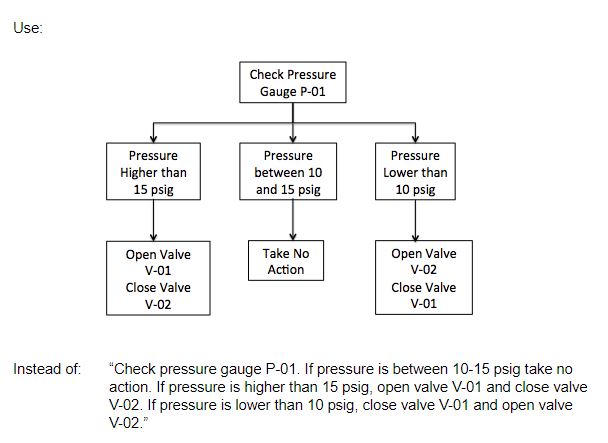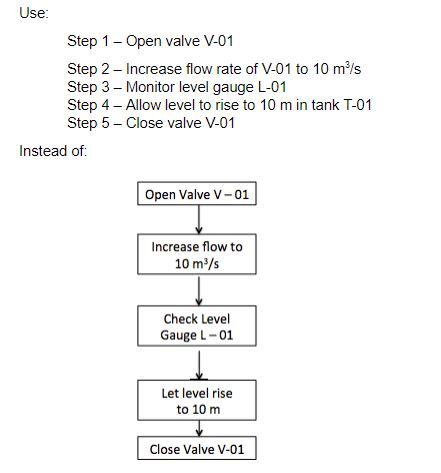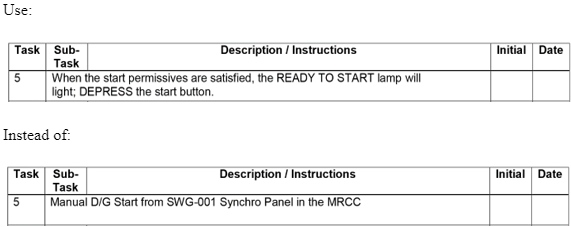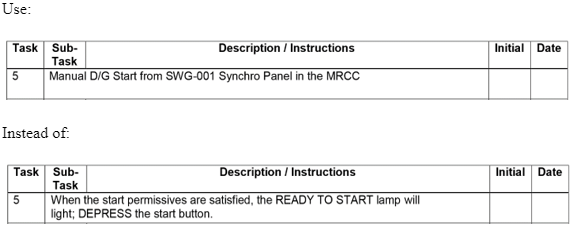Action Steps
Action steps are the principal element of operating procedures (Bovair and Kieras, 1984).
Well written action steps are imperative to the effectiveness of procedures, which lead to safety, consistency, and efficiency of worker performance (Bovair and Kieras, 1984).
Guideline 1: Action Step Phrasing
For action steps, use positive phrasing rather than negative phrasing when possible.
Support
Fewer errors are made when instructions are given with positive phrasing (Jones, 1966).
Example
Use: "Open valve VAL3"
Instead of: "Open all valves except VAL1 and VAL2"
Instead of: "Open all valves except VAL1 and VAL2"
Guideline 2: Presence of Conditional Element
If there is a conditional element in a step, start the step with the conditional term (e.g.: if, when).
Support
Readers more easily understand statements when the conditional statement comes before the action (Bovair and Kieras, 1984).
Example
Use: "IF xyz THEN close valve VAL3"
Instead of: "Close VAL3 IF xyz"
Instead of: "Close VAL3 IF xyz"
Guideline 3: Lack of Conditional Element
If a step does not contain a conditional statement, start the step with an action verb.
Support
Readers understand/properly execute instructions that start with action words more than instructions that do not (Bovair and Kieras, 1984).
Example
Use: "OPEN valve VAL3"
Instead of: "Valve VAL3 should be opened"
Instead of: "Valve VAL3 should be opened"
Guideline 4: Procedural Step Voice
Write procedural steps in the active voice.
Support
Steps written in active form are more easily understood (Olson and Filby, 1972), and remembered (File and Jew, 1973).
Example
Use: "Open the valve"
Instead of: "The valve should be opened"
Instead of: "The valve should be opened"
Guideline 5: Word Choice/Sentence Structure
Use common and simple words and sentence structures when possible.
Support
Common words and sentence structures are more easily understood (Crossley and McNamara, 2008).
Example
Use: "next to"
Instead of: "adjacent to"
Instead of: "adjacent to"
Guideline 6: Complex Step Presentation
Common practice is for steps requiring complex decision making or assessment of multiple conditional actions to be presented in a flowchart or decision table format.

Support
Flowcharts are helpful as a visual representation of how a task is to be completed (Scholtz and Maher, 2014).
Example

Guideline 7: Simple Step Presentation
Common practice is for procedural steps not requiring many conditional assessments to be presented as a text list rather than a flowchart.

Support
For simple linear procedures, the use of a flowchart does not improve operator performance or procedural adherence (Moore, 1991).
Example

Guideline 8: Actions per Step
Each step should include only one action when possible.
Support
An increase in the number of actions per step results in the complexity of the step increasing. This can result in an increase in the number of errors and likelihood that the procedure won’t be used (Park, J., Jung, W. and Ha, J., 2001).
Example
Use:
Step 1 - Open valve V-01
Step 2 - Check level gauge light L-01
Instead of:
Open valve V-01 and check level gauge light L-01
Step 1 - Open valve V-01
Step 2 - Check level gauge light L-01
Instead of:
Open valve V-01 and check level gauge light L-01
Place keepers are included at the beginning of each procedure step to ensure completion of each step by workers.
Guideline 9: Infrequent Procedure Place Keepers
Initial lines are often used in infrequently performed procedures for which workers may be unfamiliar with the procedural steps.

Support
Requiring workers to sign-off upon completion of each step increases compliance with procedure steps, particularly for procedures the worker is unfamiliar with (CCPS, 1996).
Example

Guideline 10: Frequent Procedure Place Keepers
Checkboxes are often used in frequently performed task procedures to ensure procedure use.

Support
Place keepers are important for frequently performed procedures to elicit use of procedures (CCPS, 1996).
Example

The minimum detail for all action steps should be such that the least experienced qualified worker can successfully complete them (Scholtz and Maher, 2014).
The amount of detail beyond the minimum is typically based on (Bovair and Kieras, 1984):
- Task frequency
- Worker or operator experience level
- Task complexity
- Consequence of error
Guideline 11: Action Step Detail (Novice)
Novices typically require more detailed information in a procedure.

Support
Procedure use and perceived importance decreases gradually as the effects of learning, repetition, and memorization set in (Sasangohar et al., 2018).
Example

Guideline 12: Action Step Detail (Experienced)
Experienced workers typically benefit from less detailed information.

Support
Procedure use and perceived importance decreases gradually as the effects of learning, repetition, and memorization set in (Sasangohar et al., 2018).
Example
